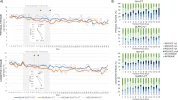A randomized comparative feasibility study of neuromodulation and cognitive training for post-COVID fatigue
Fatigue and cognitive deficits are common and disabling symptoms in patients experiencing post-COVID condition. This randomized parallel study aimed to evaluate the effects of transcranial direct current stimulation (tDCS) over the primary motor cortex combined with cognitive training (M1 + CT), compared to tDCS over the dorsolateral prefrontal cortex with cognitive training (DLPFC + CT), on fatigue, cognition, and other clinical symptoms in post-COVID.
Sixty-three patients completed the treatment (n = 32 in the M1 + CT group and n = 31 in the DLPFC + CT group) with a mean age of 47 years and an average symptom duration of 32 months. Both groups underwent comprehensive neuropsychological and clinical evaluations, including ecological momentary assessments of fatigue, at baseline, post-treatment, and one-month follow-up. The Fatigue Severity Scale (FSS) was used as the primary endpoint. Patients were randomly assigned to the M1 + CT or DLPFC + CT groups and received 15 sessions of tDCS administered concurrently with adaptive CT.
The M1 + CT group showed a slightly higher efficacy in reducing fatigue and improving sleep quality than the DLPFC + CT group. Both groups demonstrated significant improvements in cognition, anxiety, depression, pain, and sleep quality. These improvements were sustained over time.
These findings indicate that tDCS combined with cognitive training is a feasible, safe, and effective approach for reducing fatigue and enhancing cognition in post-COVID patients. The results highlight the potential of brain stimulation and cognitive training to alleviate fatigue and cognitive impairment in post-COVID, warranting further confirmation through additional randomized controlled trials.
TRIAL REGISTRATION
ClinicalTrials.gov NCT05753202.
Web | PDF | Nature Scientific Reports | Open Access
Oliver-Mas, Silvia; Matias-Guiu, Jordi A.; Delgado-Alonso, Cristina; Gil-Martínez, Lidia; Cuevas, Constanza; Polidura, Carmen; Fernández-Romero, Lucía; Matias-Guiu, Andreu; Gómez-Ruiz, Natividad; Gil-Moreno, María José; Yus-Fuertes, Miguel; Matias-Guiu, Jorge; Diez-Cirarda, Maria
Fatigue and cognitive deficits are common and disabling symptoms in patients experiencing post-COVID condition. This randomized parallel study aimed to evaluate the effects of transcranial direct current stimulation (tDCS) over the primary motor cortex combined with cognitive training (M1 + CT), compared to tDCS over the dorsolateral prefrontal cortex with cognitive training (DLPFC + CT), on fatigue, cognition, and other clinical symptoms in post-COVID.
Sixty-three patients completed the treatment (n = 32 in the M1 + CT group and n = 31 in the DLPFC + CT group) with a mean age of 47 years and an average symptom duration of 32 months. Both groups underwent comprehensive neuropsychological and clinical evaluations, including ecological momentary assessments of fatigue, at baseline, post-treatment, and one-month follow-up. The Fatigue Severity Scale (FSS) was used as the primary endpoint. Patients were randomly assigned to the M1 + CT or DLPFC + CT groups and received 15 sessions of tDCS administered concurrently with adaptive CT.
The M1 + CT group showed a slightly higher efficacy in reducing fatigue and improving sleep quality than the DLPFC + CT group. Both groups demonstrated significant improvements in cognition, anxiety, depression, pain, and sleep quality. These improvements were sustained over time.
These findings indicate that tDCS combined with cognitive training is a feasible, safe, and effective approach for reducing fatigue and enhancing cognition in post-COVID patients. The results highlight the potential of brain stimulation and cognitive training to alleviate fatigue and cognitive impairment in post-COVID, warranting further confirmation through additional randomized controlled trials.
TRIAL REGISTRATION
ClinicalTrials.gov NCT05753202.
Web | PDF | Nature Scientific Reports | Open Access


